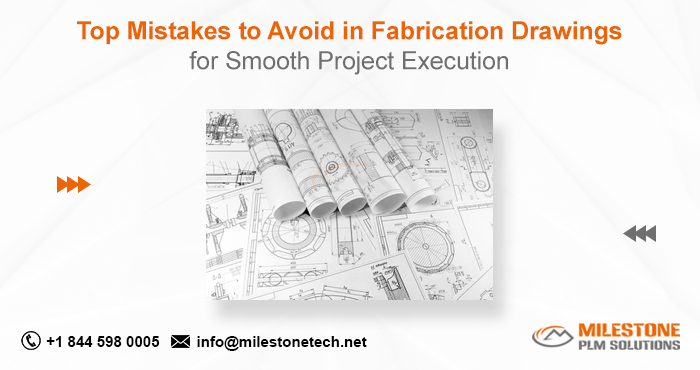Top Mistakes to Avoid in Fabrication Drawings for Smooth Project Execution
- Milestone PLM Solutions
- Nov 14, 2024
- 4 min read
Fabrication drawings are the backbone of any manufacturing or construction project, providing clear instructions for fabricating and assembling each component. When done correctly, these drawings ensure that projects run smoothly, efficiently, and with minimal rework. However, mistakes in fabrication drawings can lead to costly delays, material waste, and communication breakdowns between teams. To avoid these pitfalls, it’s essential to know the common mistakes made in fabrication drawings and how to avoid them. Here are the top mistakes to watch out for to ensure smooth project execution.

1. Incomplete or Vague Dimensions
Problem: One of the most frequent mistakes in fabrication drawings is providing incomplete or unclear dimensions. Missing dimensions or incorrect tolerances can lead to parts that don’t fit together properly, requiring costly adjustments on the shop floor.
Solution: Ensure that every critical dimension is clearly specified, including tolerances. Double-check drawings for accuracy and completeness. Include all necessary measurements and double dimensions for important or interlocking parts. Using standard tolerances and avoiding ambiguity in measurements are essential for reducing potential errors.
2. Inconsistent or Missing Welding Symbols
Problem: Welding details are crucial in fabrication drawings, especially for structural projects. Missing or incorrect welding symbols can lead to weak or improperly joined structures, impacting safety and durability.
Solution: Follow standard welding symbols and check for consistency throughout the drawing. Use American Welding Society (AWS) standards or other recognized symbols to avoid confusion. Clearly indicate the type, size, and length of welds, ensuring welders have the right instructions to create strong, reliable connections.
3. Lack of Material Specifications
Problem: Material specifications are essential for ensuring that parts meet performance requirements. Failure to list the correct materials or grades can lead to components that fail under stress, affecting the entire structure’s integrity.
Solution: List all material specifications in detail, including grades, finishes, and any additional treatment (like galvanizing or painting). Use a material callout table within the drawings, and confirm that the specified materials align with the project’s requirements.
4. Ignoring Assembly Sequence and Clear Part Identification
Problem: Fabrication drawings that lack assembly sequences or clear part identification can lead to confusion during assembly. Without a clear order of operations, assemblers may struggle to piece parts together efficiently, leading to delays and errors.
Solution: Include an assembly sequence and part numbering system in the drawings. Provide a logical, step-by-step order to guide the team through the assembly process. A Bill of Materials (BOM) with part identifiers can further streamline assembly and prevent confusion. Use consistent labeling, and avoid vague descriptions or references.
5. Not Accounting for Tolerances and Fit
Problem: Overlooking tolerances can result in parts that are too tight or too loose, leading to issues during assembly. Parts that don’t fit together as intended may require modification or complete re-fabrication, causing project delays.
Solution: Define tolerances for all critical dimensions to ensure compatibility between parts. Ensure that fabrication tolerances align with industry standards and project requirements. Consider thermal expansion, contraction, and allowances for movement in your tolerance specifications.
6. Overcomplicating the Drawing Layout
Problem: Overly complex or cluttered drawings are difficult to interpret, which can lead to miscommunication and mistakes on the shop floor. Drawings that include too many details in a single view make it challenging for fabricators to understand the intended design.
Solution: Keep drawings clear and organized by separating views and focusing on critical details. Use multiple views to clarify different sections or angles of complex parts. Avoid overcrowding the drawing space, and use layers or exploded views when necessary to improve readability. A well-organized drawing helps ensure that fabricators can easily follow the design.
7. Neglecting Quality Control and Drawing Review
Problem: Rushing through fabrication drawing preparation without thorough review and quality control can lead to overlooked errors. These unchecked mistakes can create major setbacks once the project is in production.
Solution: Implement a quality control process that includes drawing reviews and cross-checks. Have multiple team members review drawings for accuracy, consistency, and clarity before they reach the shop floor. This step may involve engineers, designers, and project managers to ensure the drawing meets all necessary requirements.
8. Forgetting to Update Drawings with Changes
Problem: Changes to the design often happen during the course of a project, but if these changes aren’t reflected in the fabrication drawings, it can lead to serious issues on the production floor.
Solution: Establish a clear revision process for updating and distributing changes. Clearly mark all revised sections and keep a record of changes within the drawing itself. Notify all relevant team members of the updated drawings to prevent outdated instructions from causing issues.
Conclusion
Fabrication drawings are integral to smooth project execution, but errors in these drawings can have significant consequences. By avoiding these common mistakes, manufacturers and construction teams can save time, reduce costs, and improve overall project quality. Paying close attention to dimensions, materials, tolerances, and review processes helps ensure that every drawing provides the clear, detailed guidance necessary for accurate fabrication. When fabrication drawings are prepared correctly, they become valuable tools that contribute to seamless, error-free production


